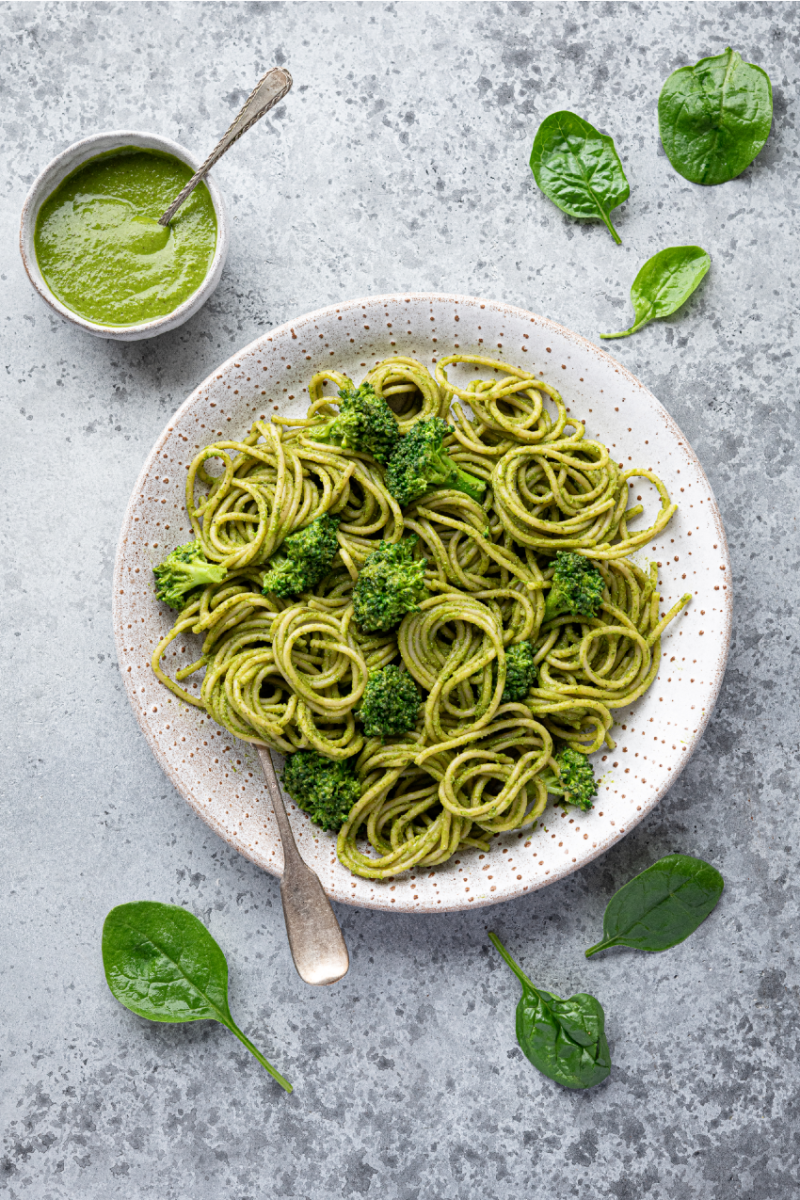Explore the benefits of eating leafy greens and how to incorporate them into your daily meals
Ever since we were young, we have been told to eat our greens. And for good reason – few foods boast such nutrient density as the humble leafy green vegetables. These foods are incredible, but how can we incorporate them into our diet in a delicious, balanced and sustainable way?
First of all, we need to be clear on what counts as a leafy green. These versatile veggies extend beyond lettuce! As their name suggests, any consumable leaves of plants count as part of this group. There is such a wide range of greens, so everyone is bound to find one they like! A small selection of this diverse food group includes kale, spinach, Swiss chard, watercress, rocket, pak choy, spring onions, cabbage, Brussels sprouts and collard greens.
Dark leafy greens prove to be some of the most nutritious foods on this planet. While I was studying nutrition at university, my classmates and I would often joke that if somebody asked you what food contains a particular micronutrient, you'd nearly always be right if you answered 'dark green leafy vegetables'! Dark leafy greens excel in both the vitamin and mineral department. In particular, they contain high levels of vitamin A, C and K with a wide range of minerals such as iron, copper, calcium and magnesium. They are also rich in antioxidants and fibre.
How can we eat more of these powerhouse vegetables?
Perhaps you are thinking that the colder the weather, the less appetising salads become? Thankfully, the wide variety of leafy greens results in a diversity of ways to consume them. By mixing up cooking methods and dressing leafy greens in different flavours, the opportunities for including them in your daily diet are endless.
Here are just some ideas on how to incorporate these mighty green vegetables into your diet:
Spinach – This has a mild taste which makes it incredibly versatile! Blend it into smoothies, and stir it into curries or casseroles for an easy nutrient boost. You can buy spinach pre-frozen in chunks and keep it in your freezer for easy access.
Kale – An easy side dish for any meal is to chop kale into small chunks, and to stir-fry them with a red chilli and a couple of crushed garlic cloves until the leaves have softened. Alternatively, you can roast or air-fry kale to create a crispy texture. Top it with nutritional yeast, a small pinch of salt and black pepper and enjoy it as a healthy savoury snack.
Cabbage – Gut health has been in the spotlight for a few years now, which has increased the popularity of fermented foods such as sauerkraut and kimchi. Sauerkraut is a German dish that is made from fermented cabbage. Similarly, kimchi is a Korean dish made from cabbage, other vegetables and gochutgaru (a type of chilli paste). Both are available in many supermarkets, however they are surprisingly easy to make at home. These fermented foods can take flavour to the next level whilst adding extra nutrients and gut health benefits.
Brussels sprouts – Some may loathe them, some may love them. If Brussels sprouts are your thing, try roasting them until golden brown with vegan-friendly garlic butter.
Not keen on the texture?
If you’re trying to eat more leafy greens but the texture simply isn’t working for you, consider blending your cooked greens to create a sauce. For example, stir fry onion, garlic and spinach and then blend with a handful of soaked cashews, water and a generous amount of pesto to create a creamy, tasty sauce that can be enjoyed with pasta or gnocchi. And check out Chantal’s delicious pesto recipe on the next page!
These are just some ideas to spark creativity when trying to include leafy greens into your diet. Don’t be afraid to experiment with cooking methods and flavour combinations to fit your taste buds.
Spinach Pesto Pasta
Serves 4
Try out this green-packed and delicious recipe, created by dietitian Chantal Tomlinson.
Ingredients
- 400 g wholewheat pasta (spaghetti works nicely)
- 100 g spinach
- 1 tbsp dried basil
- 175 g canned green peas
- 1 tbsp rapeseed oil
- Juice of ½ lemon
- 2 tbsp nutritional yeast
- 4 tbsp pasta water
- 2 cloves garlic
- Small pinch of salt
- Pepper to taste
- 200 g broccoli chopped into small florets
Method
- Start boiling the pasta, following the instructions on the packet.
- While the pasta is boiling, place all the other ingredients (apart from the broccoli) in a blender, and blend them until the mixture is smooth.
- Place the broccoli in a steamer or a colander over a pan of boiling water, cover with a lid and steam for about 5 minutes. Save energy by steaming the broccoli over the boiling pasta.
- Serve individual portion of pasta, desired amount of pesto, broccoli and combine. Enjoy!
Nutritional information per portion
|
Energy |
Fat |
Saturated fat |
Carbohydrates |
Sugar |
Fibre |
Protein |
Salt |
|
453 kcal |
7.1 g |
1 g |
67 g |
6.2 g |
15 g |
22 g |
0.7 g |
By Manon Williams, Dietitian
This article was first published in The Vegan 2023 Issue 1. The Vegan is our quarterly in-house members’ exclusive magazine featuring interviews, reviews, recipes, deep dives into veganism, and more! To receive your copy, please join us to support our work to help people go and stay vegan, and protect the rights of existing vegans.
Explore our nutrition and health resources to find out how to get the most out of your vegan lifestyle. Search through our recipe hub and explore a variety of delicious vegan dishes that cater to every taste and occasion.
The views expressed by our bloggers are not necessarily the views of The Vegan Society.

